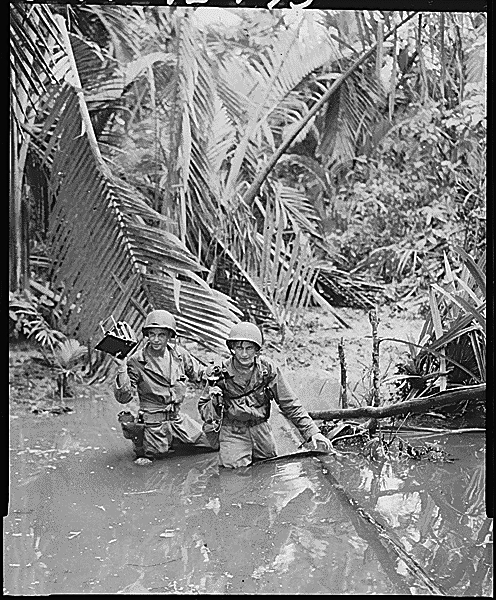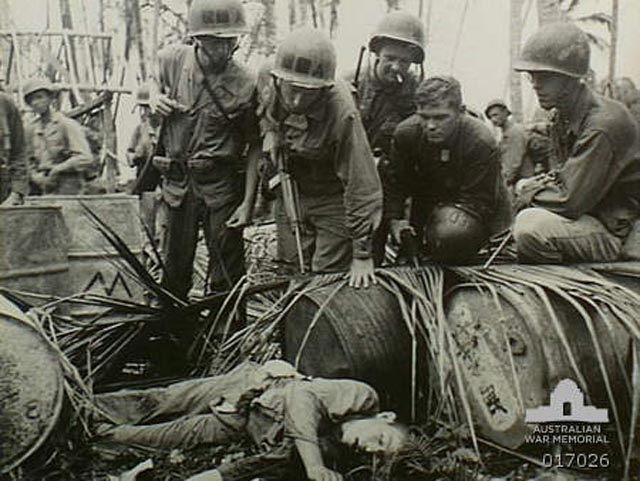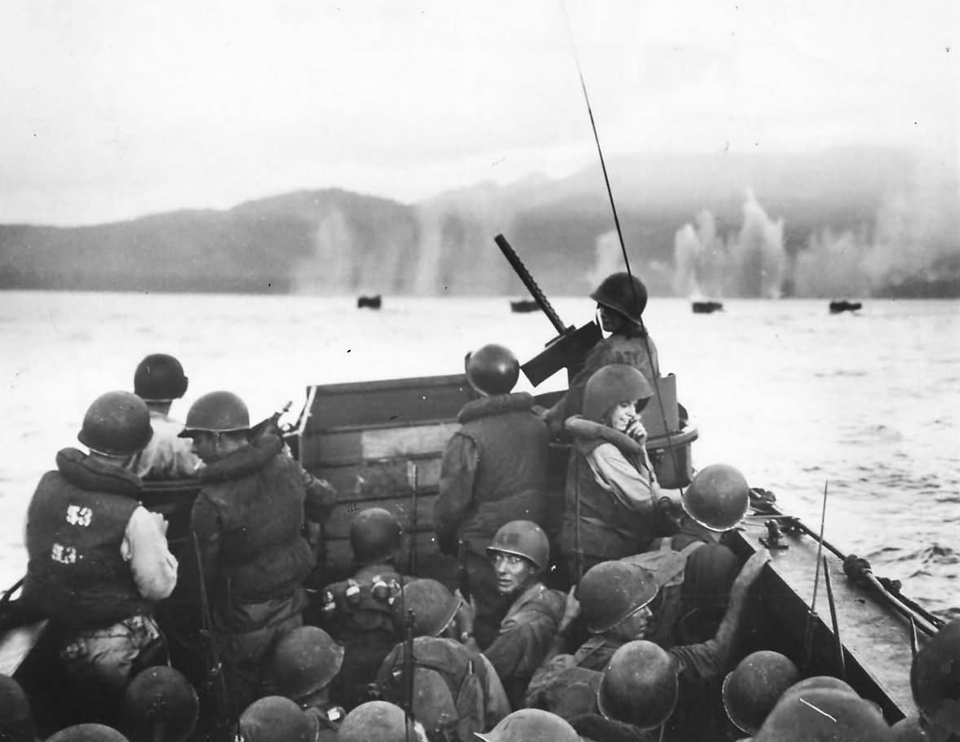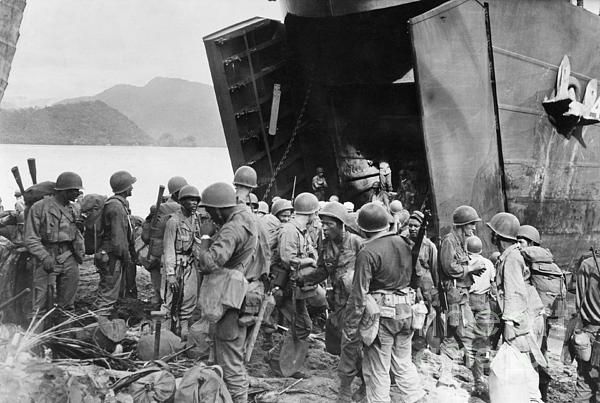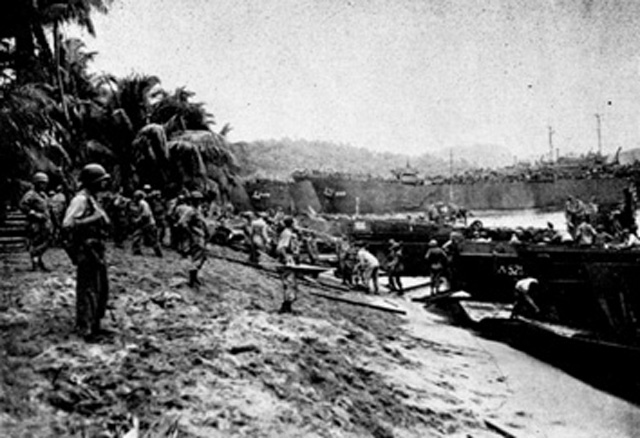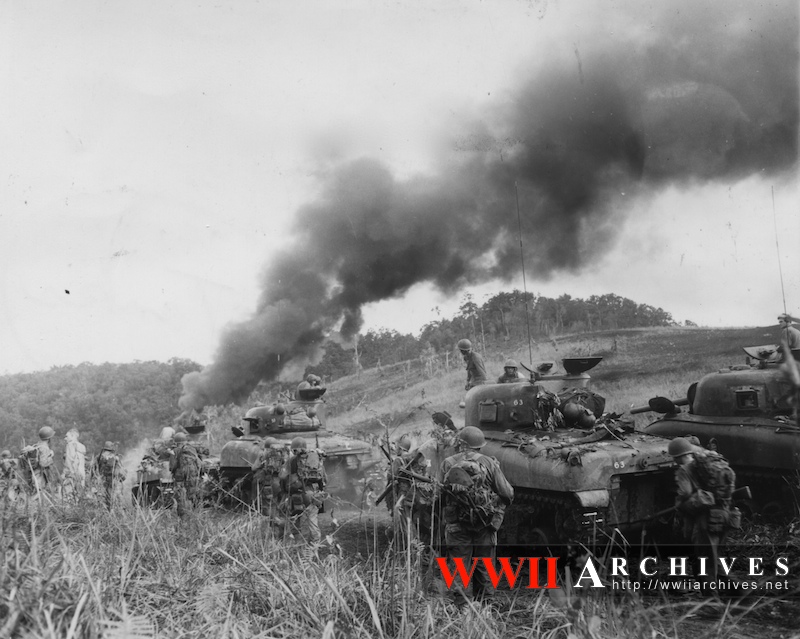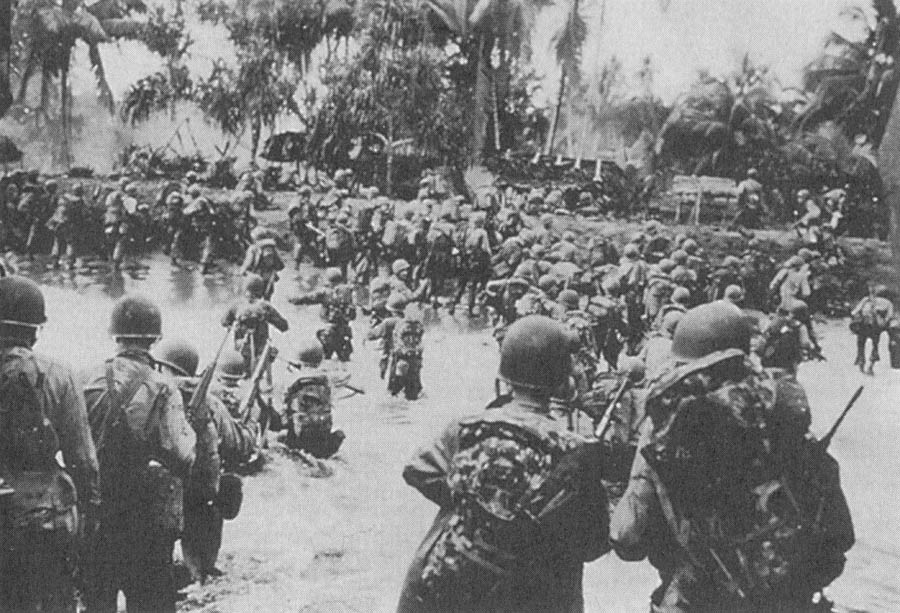Air Operations, Carolines
- 5th Heavy Bomb Group B-24s attack the Woleai Atoll.
- During the night, 17 XIII Bomber Command B-24s attack the Truk Atoll.
Air Operations, CBI
BURMA- 12 10th Air Force B-25s attack Kamaing.
- 5 B-25s and 6 P-51s attack ammunition and supply dumps at Hopin.
- 3 B-25s and 4 P-51s attack an occupied village near Bhamo.
- 7 P-51s attack the viaduct at Gokteik.
- 14 Air Force P-40s attack road and rail traffic near Lashio.
- 6 308th Heavy Bomb Group B-24s attack 4 freighters and a Japanese Navy gunboat near Cap St.-Jacques.
- 1 B-24 attacks a bridge near Vinh.
- More than 30 10th Air Force A-31s attack Bishenpur and Kohima.
Air Operations, Europe
American B-17 and B-24 aircraft raid the rail installations at Hamm plus other rail junctions and ground fortifications.
RAF BOMBER COMMANDEvening Ops:
- 596 aircraft are sent to Düsseldorf. In this total are 323 Lancasters, 254 Halifaxes and 19 Mosquitos from all groups except No. 5.
- 2,150 tons of bombs are dropped in an old-style heavy attack on a German city which causes much destruction. The attack falls mostly on the northern parts of the city which causes widespread damage. Night-fighters do penetrate the bomber stream causing a lot of casualties.
- 16 Halifaxes and 13 Lancasters are lost.
- 238 Lancasters and 17 Mosquitos of No. 5 Group and 10 Lancasters of No. 1 Group are sent to Brunswick. This raid is of importance to the history of the bombing war in that it is the first time the No. 5 Group low-level marking method is used over a heavily defended German city. The raid, however, is not successful. The initial marking by No. 617 Squadron Mosquitos is accurate, but many of the main force bombers do not bomb these partly because of a thin cloud layer which hampered visibility and partly because of faulty communications between the various bomber controllers. Many bombs fall in the city center but the remainder of the force bomb reserve H2S-aimed target indicators which are well to the south.
- 4 Lancasters are lost.
- 181 aircraft are sent to the Laon railway yards. Included in this total are 69 Halifaxes, 52 Lancasters, 48 Stirlings and 12 Mosquitos of Nos. 3, 4, 6 and 8 Groups. The attack is carried out in 2 waves and severe damage is caused.
- 4 Lancasters, 3 Stirlings and 2 Halifaxes are lost including the aircraft of one of the Master Bombers, Wing Commander A. G. S. Cousens of No. 635 Squadron who is killed.
- 17 Mosquitos make a diversionary raid to Mannheim, 2 Mosquitos to a flying bomb store at Wissant, 19 aircraft make leaflet flights, and there are 19 Serrate and 7 Intruder patrols.
- There are no losses.
GERMANY:
- Of 803 8th Air Force heavy bombers dispatched against marshalling yards at Hamm, 398 B-17s and 240 B-24s attack the primaries, 15 B-24s attack the city of Hamm, 20 B-24s attack Bonn, 50 B-17s attack Koblenz, 19 B-17s attack Soest, and 37 B-17s attack various targets of opportunity.
- 1 heavy bomber is lost over the Continent, but 14 others are downed when Luftwaffe fighters infiltrate the returning bomber streams over England after dark
- Escort for the heavy bombers is provided by 859 USAAF fighters, including 314 on load from IX Fighter Command. After escort duties, 356th Fighter Group P-47s conduct dive-bombing attacks with 100-pound bombs on targets of opportunity encountered during the return flight. 8th and 9th escort pilots down 36 Luftwaffe fighters over Germany between 1240 and 1530 hours.
- 13 USAAF fighters are lost with 12 pilots
BELGIUM:
- Approximately 275 9th Air Force P-47s and P-51s attack several marshalling yards in Belgium.
- A total of more than 400 IX Bomber Command B-26 sorties and nearly 90 A-20 sorties are mounted throughout the day against V-weapons sites around St.-Omer and Hesdin.
ITALY:
- 12th Air Force B-25s and B-26s attack bridges and rail lines in central Italy, the town area at Orvieto, and the harbor at San Stefano al Mare.
- XII TAC A-20s attack a town and ammo dumps.
- XII TAC fighter-bomgers attack gun emplacements around the Anzio beachhead, a marshalling yard at Siena, various rail targets in the Florence area, and four towns.
Air Operations, New Guinea
- Supported by US Navy surface warships and Task Group 78.1 carrier aircraft, US Army ground forces make several unopposed landings in the Hollandia area.
- Task Force 58 carrier aircraft are on hand to attack Aitape, Tanahmerah Bay, and Humboldt Bay, but scheduled strikes in support of the US Army landing at Tanahmerah Bay are cancelled when it becomes known that the landing area is undefended. However, a TBM strike aimed at detonating mines on the Tanahmerah Bay landing beach is completed, as is an anti-mine bombing mission undertaken by TBMs against the landing beaches at Humboldt Bay.
- In the day’s only aerial engagement, 7 VF-10 F6Fs share in the downing of 1 Ki-21 'Sally' medium bomber over Hollandia at 0812 hours.
- More than 20 380th Heavy Bomb Group B-24s based in Australia attack airfields on Noemfoor Island.
- More than 80 V Bomber Command B-24s and A-20s attack the airfields at Boram and But.
- More than 100 B-24s and B-25s attack the Hansa Bay area.
- 11 417th Light Bomb Group A-20s attack the Tadji airfield on Hollandia.
- Many small attacks are conducted by V Bomber Command bombers and V Fighter Command fighters and fighter-bombers in indirect support of the landings at Hollandia.
Battle of the Atlantic
During the night the Canadian frigate Matane obtained an asdic contact and moments later a visual confirmation. Low on fuel, the Matane is only able to deliver one deep pattern before losing contact. It is believed that the U-boat, U-311, was lost in this attack as no further signal was received from her.
| Class | Type VII |
| CO | Kapitänleutnant Joachim Zander |
| Location | N Atlantic |
| Cause | Depth charge |
| Casualties | 51 |
| Survivors | None |
CBI
Elements of the US 1st Provisional Tank Group support Chinese infantry near Warazup.
[China
The Japanese capture Chengchow (Honan).
[Diplomatic Relations
Russia concludes peace talks with Finland.
[Marshalls
US forces occupy Ungelap Island completing the campaign for the group. the capture of the Marshall Islands enables US forces in the central Pacific to begin their swing northward up through the Mariana Islands toward the Japanese homeland.
[Mediterranean
Yugoslav Partisans occupy the German-held island of Korcula in the Adriatic.
[New Britain
The marines fight the final engagement with elements of Japanese forces in western New Britain. The campaign has cost the Americans 310 killed and 1,083 wounded and has been fought in some of the most forbidding conditions any combat unit will encounter in the Second World War. The Japanese have lost nearly three times the number of casualties and are now clustered around Rabaul,. virtual prisoners and no longer a factor in the war.
[New Guinea
The US operations against the Japanese positions at Hollandia and nearby begin. The landing forces are carried by the ships of Rear-Adm Daniel Barbey's TF 77. Adms Victor Crutchley and Russell Berkey lead cruiser forces in the covering group in which there are also 2 escort-carrier squadrons. Adm Mitscher's carriers which made several of the preparatory raids remain in support. The landing force, I US Corps, is under the overall command of Gen Robert Eichelberger and totals 84,000 men. The defenders are from the Japanese 18th Army and are commanded by Gen Hatazo Adachi and number 11,000. The landings begin at 7:00a.m. Initially there are 3 landings. 1 regt is put ashore at Aitape; Gen Frederick Irving's 24th Inf Div at Tanahmerah Bay; and Gen Horace Fuller's 41st Div at Humboldt Bay. There is comparatively little resistance at first. The Japanese are taken somewhat by surprise and retire inland to the nearby mountains leaving for the moment only harassing forces. The Americans immediately penetrate inland as far as Pim and Jangkena, 8 miles from the coast, meeting resistance only near the airfields at Sentani and Cyclops, so called by the Americans. The Japanese counter-attack by night, but to no effect.[MORE]
[Pacific
The British submarine Taurus sinks the Japanese salvage vessel Hokuan I-Go off Malaya.
[Images from April 22, 1944
|
|
|
|
|
|
|
|
